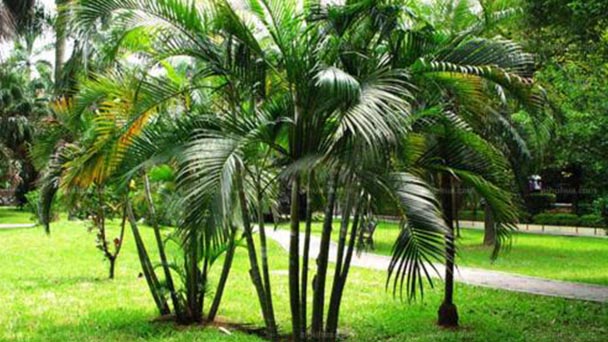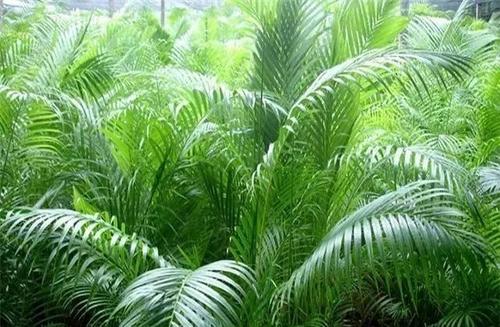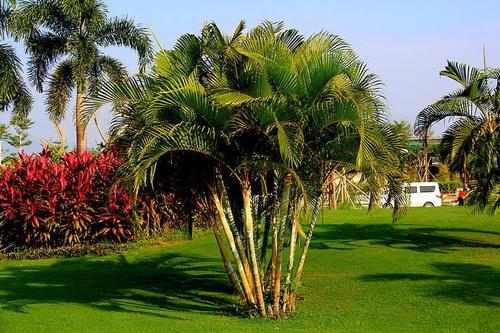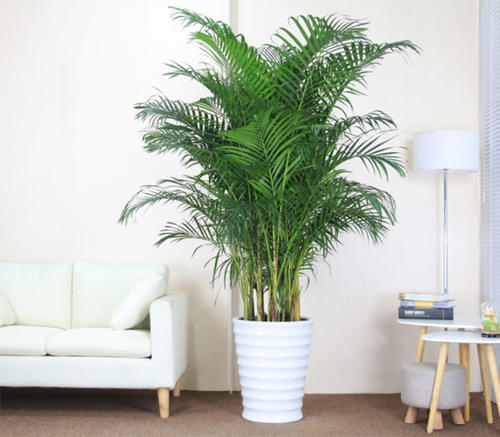Areca Palm Profile: Plant Info & Complete Growing Guide
Written by Maggie
Dec 15 2021

Areca palm belongs to a cluster of evergreen shrubs or small trees. Areca palm is originally from Madagascar Island of Africa. Now it is commonly cultivated in some garden units in southern China and potted as interior decoration.
Areca Palm Picture
Growth Habits of Areca Palm
Areca palm is a tropical plant that likes a warm, moist and semi-shady environment. Areca palm cold resistance is not strong, the temperature below 20℃ leaves yellow, the minimum temperature over the winter should be above 10℃, 5℃ or so will freeze to death. Therefore, it is still possible to cultivate in the open field in South China, and the Yangtze River valley and its north areas should be conserved in greenhouses. Growth is slow at the seedling stage and rapid afterwards. Areca palm is suitable for loose, well drained, fertile soil. Areca palm has dense branches and leaves, evergreen, strong shade tolerance.
Characteristics of Areca Palm
Areca palm is a cluster of evergreen shrubs or small trees. Stems are smooth, yellowish green, without burr, covered with wax powder when tender, stem base ringed, pinnate compound leaves, split, extended, arched. Leaves of Areca palm are lanceolate, apex acuminate, soft.Flowers monoecious, small and golden;Inflorescences of spikelets are born under sheaths of leaves, much branched, panicles about 0.8m long, with 2 to 3 branches, branched inflorescences 10 to 30cm long, with 8 to 12 spikelets. Spirally growing; Male flowers are with 3 sepals and 3 petals each, refractory stamens 6; Female sepals and petals of Areca palm are as male, ovary 1-loculed, with short styles and thick stigmas. Leaves are smooth and slender, simple, pinnately lobed, 40 -- 150cm long, petiole slightly curved, apex soft; Lobes of Areca palm are lanceolate, asymmetrical left and right sides, central lobes about 50cm long, apical lobes only 10cm, terminal length acuminate, usually 2 short lobes, dorsal main veins raised; Petiole, leaf axis and leaf sheath are yellowish green; Leaf sheaths cylindric, phimosis. Inflorescences of Areca palm are paniculate, under leaf sheaths, many branches, ca. 40cm long, 50cm wide; Fruit is suborbicular, 1.2cm long, 1.1cm wide, orange. Areca palm has 1-3 seeds, ovate to elliptic. The base is multi-tiller and grows in clumps. Fruit is slightly gyroscopic or obovate, about 1.8cm long, about 1cm in diameter, yellow when fresh, purple black when dry, without endocarp. Cultivation rarely yields fruit. The seed is slightly obovate, the endosperm is uniform, the center has the narrow long cavity, the embryo is born laterally.
Areca Palm Distribution
Areca palm is originally from Madagascar, now introduced in southern provinces of China. Areca palm is suitable for growing in South China and Southwest China.
How to Grow & Care for Areca Palm
1. Soil: Areca Palm should choose slightly acidic soil for indoor potting, and sandy loam with high humus content should be chosen in the north. Leaf-rot soil, peat soil, 1/3 river sand and part of the base fertilizer can be used to prepare culture soil. Tiller buds of Areca palm grow more on the root stem, potted because of the original plant a little deeper, so that the new buds do not take root better.
2. Temperature: Areca palm likes warmth, and the optimal growth temperature is 20-35 ℃. If more than 35℃ or less than 10℃, slightly improper cultivation management, the foot leaves will turn yellow from green. Winter needs to do a good job of insulation and antifreeze work, generally about 10℃ can be relatively safe in winter, if the temperature is too low, the leaves will yellow, leaf tip dry, and lead to root damage, affecting the growth of the next year.
3. Watering: Areca Palm should follow the principle of dry and wet according to the season. In dry and hot seasons, water more appropriately, and control watering in low temperature and rainy.In northern areas, especially in places where water contains more salt and alkali, it should be noted that black alum is often used to regulate soil acidity. Always keep the basin soil moist. Summer and autumn high temperature period, but often maintain a high air humidity around the plant, but by all means avoid basin soil water, so as not to cause root rot.
4. Lighting: Areca palm should be shaded in summer, and direct sunlight is the most avoided. Even a short period of exposure will cause the leaves to brown, which is difficult to recover. Areca palm likes half shade, spring, summer, autumn three seasons should shade 50%. Indoor cultivation and ornamental should be placed in the place with strong scattered light, and can withstand dark environments, but it should be regularly moved to the outdoor light for better maintenance and recovery to maintain a higher ornamental state.
5. Fertilization: Areca palm should apply decaying liquid fertilizer or compound fertilizer once every 1 to 2 weeks to promote the vigorous growth of the plant and the dark green leaf color. Nitrogen-containing organic fertilizer should be applied appropriately in summer, and organic flower fertilizer such as sesame paste residue can be applied in winter while keeping the soil dry and wet in the pot.
6. Transplanting, Areca palm seedlings when the plate in the pelvic floor in the first 2 ~ 3 cm thick coarse grained matrix as a filter layer, cover it with full of rotten organic fertilizer as basal, thickness is about 1 ~ 2 cm, then cover with a thin layer of substrate, about 1 ~ 2 cm thick, and then into the plant, in order to separate the fertilizer from the root, avoid burning roots.
7. Puning: After two years of continuous leaf picking for leaf cutting cultivation, Areca palm should carry out comprehensive rejuvenation of the plants and maintenance of necessary equipment, mainly the maintenance of shading equipment, because with the continuous growth of the plants, the shading equipment cannot meet the requirements of the growth height of the plants, and it is easy to break the shading net in typhoon season. The second is the rejuvenation of the plant.
8. Repot: Areca palm should be repot every 2 ~ 3 years in early spring, and old plants can be repot every 3 ~ 4 years. After changing the pot, should be placed in half shade and the place with higher air humidity, still need to cut off withered and yellow branches and leaves in time.
Read More:
How to Care for Areca Palm
Areca Palm Plant Care for Yellow Leaves & Leaf Tips Burnt

Areca Palm - one of the best indoor trees
How to Propagate Areca palm
1. Sowing: If Areca palm can obtain seeds, it can wash the harvested fruit flesh, soak the seeds in 35℃ warm water for two days, and plant them as they germinate. In sunny days, it should spray foliar water more often, and generally grow slowly in the young stage but rapidly after mature.
2. Splitting: Splitting and breeding of Areca palm can be carried out all the year round. It is usually carried out in combination with pot replacement around April. General conservation 1 ~ 2 years can become potted goods.
Read More: How to Propagate Areca Palm
Areca Palm Citrus & Shield Scale Care
1. Symptoms: 1 ~ 2 generations occur every year. Adults and nymphs of Areca palm are attached to leaves and petioles to suck juice, affecting plant growth.
2. Prevention and control: when a small amount of insect body is found, it should be timely scraped off. When the amount of occurrence is large, spray 50% colloid thiophosphorus 800 times liquid, spray 2 ~ 3 times is appropriate.
Areca Palm Root Rot Care
1. The soil in the pot is too dry: Areca palm needs to be supplied with sufficient water during its growth. When the soil in the basin is dry for a long period of time, the leaf tips and leaf edges will dry out and scorch because the plants cannot get enough water to grow.
2. Excessive sunshine: Areca palm prefers semi-overcast environments, and leaves will turn yellow, focal tip and focal edge when exposed to direct sunlight. During this period, Areca palm should be placed under shade or trees, to avoid direct sunlight.
3. The basin soil is too wet: it is not as long as there is water in the basin soil, plants can absorb and use. When the soil in the basin is too wet, the respiration of the plant roots will be affected, and the absorption of water by the roots will be affected, and the focal tip and focal edge of the leaves will appear due to the lack of water in the plant body.
4. Too dry: Areca palm likes high air humidity, and too dry air will cause a focal tip and focal edge of leaves. Water should be sprayed on the foliage and surrounding environment 3-4 times a day throughout the growth period to increase air humidity. But stop watering after hibernation.
5. Too much fertilization: Too much fertilization will cause the reverse osmosis phenomenon of plant root cells and make the plant water lose. To a lesser extent, it will lead to the focal tip and focal edge of leaves, and in serious cases, it will cause the death of rotten roots.
Areca Palm Leaf Blight Care
1. Symptoms: The pathogen first infects the leaf tip and leaf margin. At the initial stage of infection, the spots or patches show brown spots or patches; at the middle stage, the spots or patches gradually expand and connect with each other; at the later stage, the leaves show gray and white dry.
2. Law: pathogenic bacteria overwinter on the infected plant or in the soil, spread by conidia through wind, rain and spray watering, and the pathogen invades from the plant wound. High temperature, high humidity and dense not ventilated environment susceptible to this disease.
3. Prevention and treatment: strengthen disease inspection, not the introduction of diseased Areca palm, strengthening ventilation, the period to avoid the rain and spray, will suffer the branches cut off in time, prevent continue impregnation, pruning wounds of cognis daub ointment after processing, such as a disease had a 70% available mildothane, 800 or 75% chlorothalonil 1000 times liquid spraying, 7 to 10 days between spraying time, 3 to 4 times in a row, can effectively control the condition.

Latest Updated
- Benefits of Bugleweed - 7 Science-backed Health Benefits
- Bugleweed Dangers & Side Effects - Is It Poisonous?
- How to Plant Evergreen Trees - What You Should Know
- When to Plant Evergreens - Grow Guide for Evergreen Trees
- 12 Wonderful Evergreen Shrubs for Your Garden
- 12 Popular Evergreen Plants with Pictures for Beginners
- When And How To Prune A Lilac Bush Like a Pro
- How to Grow & Care for Lilac Vine (Hardenbergia Violacea)
- Japanese Lilac Tree (Syringa Reticulata) Care & Propagation Guide
- Shumard Oak Pros and Cons - What to Know
Popular Articles
- Winter maintenance of Antirrhinum Majus
- How to Grow Terminalia Mantaly Tree
- How to Grow and Care for Crossostephium Chinense
- How to grow Antirrhinum Majus in spring
- Peristeria Elata (Dove Orchid) Profile: Info & Care Guide
- Underwatered Snake Plant (Sansevieria Trifasciata) - Signs And How To Fix
- How to Care for Brazilian Jasmine Plant (Mandevilla Sanderi)
- How to Grow & Care for Graptopetalum Purple Delight in Summer
- Rosa Chinensis (China Rose): Plant Growing & Care Tips
- How to Care for Baby Sun Rose (Aptenia Cordifolia)
